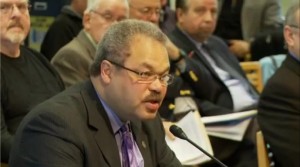Harsh criticism of the Columbia River Crossing Light Rail Tolling project (CRC) came from residents of Portland’s northern neighborhoods during the March meeting of Oregon’s Joint Committee on Legislative Oversight on the CRC. Speakers representing the north and northeast Portland communities were unanimous in their belief that current plans of the CRC fail to adequately address their acute concerns.
From their location near the south side of the existing Interstate Bridge, north Portlanders see all too clearly the devastating effects of the traffic situation as it currently stands. Lew Frederick, State Representative for Oregon House District 43 (which covers the entirety of north and northeast Portland), represents the area of Oregon that has been hit hardest by daily car and truck congestion that occurs along the I-5 corridor. He strongly questions the “priorities” of the CRC plan as it continues to plow forward.
Topping his list of concerns is air quality in the neighborhoods most profoundly affected by I-5 traffic.“Pollution caused by internal combustion engines in my legislative district is horrendous,” said Frederick. “And we have the incidence of asthma and other chronic respiratory diseases to prove it. It is no accident that the freeway was built through historically poor and minority communities, and I have not seen evidence that this plan under consideration will make people’s lives better in my district.”
Questions of air quality are of particular importance to David Sweet, Northeast Coalition of Neighborhoods (NECN) representative. As Co-Chair of the NECN Land Use and Transportation Committee, Sweet voiced apprehensions about the cost of the CRC and its ultimate inability to solve crucial traffic and pollution issues.
“While temporarily relieving some I-5 congestion near the Columbia River,” he said, “the CRC megaproject will funnel more traffic into existing congestions in the neighborhoods we represent.”
According to Sweet, the exhaust produced by this increase in traffic will only add to the “carcinogenic cloud” of benzene, formaldehyde, and diesel particulate that currently hangs over northeast Portland neighborhoods.
Like Rep. Frederick, Sweet also presents the racial and economic demographics of these affected neighborhoods as a topic of significant concern. “This area houses one quarter of the state’s African-American population,” he said. “To knowingly bring more pollution and congestion to these racially diverse neighborhoods would add insult to the many historic injustices visited on the residents of our community.”
In summation, Sweet condemned the current CRC plan, explaining, “There are better ways to reduce congestion, there are better ways to move freight, and there are certainly better ways to create jobs for Oregon.”
This last comment by Sweet echoed sentiments voiced earlier by Rep. Frederick. Responding to CRC promises of employment opportunities for individuals in and near their proposed areas of construction, Frederick said, “A short-term promise of construction jobs—even if I believed that workers in my district would get those jobs—does not justify the long-term health effects by continuing to bring pollution into these neighborhoods.”
An overwhelming majority of Oregon and Washington residents agree that the current traffic situation on and near the Interstate Bridge is simply untenable, and Rep. Frederick is certainly a vocal part of this majority. “I’m not here to be a knee-jerk naysayer,” he said. “I want changes in how we move people and stuff through, into, and out of north and northeast Portland in particular. I want infrastructure that will serve that function for many years to come.”
But critical questions remain. Which communities will benefit most from transportation projects as they continue to develop; and which will bear the brunt of these projects’ negative effects?
“My expectation is that we will look at all alternatives in a comprehensive, structured way with a well-defined set of priorities and goals to measure those alternatives against.” said Frederick. “If [the CRC] plan is implemented, who’s life will be better? Who’s life will be worse? Who will fail to improve? If the CRC project is successful, what will it look like for the environment, for commerce, for residents? These questions have to be answered on behalf of the entire region, but especially on behalf of those who live and breathe in north and northeast Portland.”











[...] strongly questions the ‘priorities’ of the CRC plan as it continues to plow forward” it was reported at the [...]